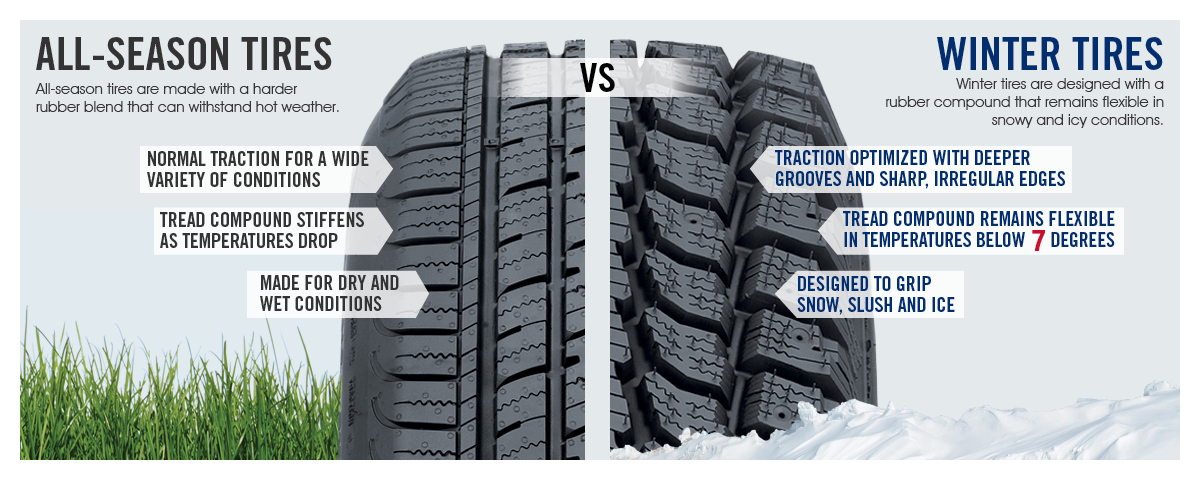Oct 2017
Increased Safety Makes Winter Tires Worth the Cost
As the leaves change color and begin to fall, and the temperature drops along with them, it’s likely some nostalgic thoughts some to mind…football, family gatherings, building snowmen, and sipping hot cocoa. But knowing that months of cold weather are ahead also means it’s time to begin winterizing preparations, such as getting the shovels and cold-weather gear out of storage, buying road salt, stocking up on firewood, and prepping you vehicle.
But vehicle prep goes beyond just checking your battery, lights, and antifreeze and washer fluid levels. One growing trend that helps to combat the treacherous road conditions that come along with the snow-laden months is the use of winter tires. These specially designed tires utilize sophisticated tread designs and are composed of more flexible rubber compounds, resulting in improved performance in cold-weather conditions. And as we all know, the Northern US and Canadian winters do a great job of delivering these conditions. So with another frigid winter on the horizon, it’s essential to be prepared.
Improved Performance
It’s a proven fact that winter tires offer improved safety over all-season tires through better handling, braking, cornering, and traction. A 2016 University of Michigan study found that stopping-distance performance of winter tires on packed snow is typically about 35% shorter than all-season tires and 50% shorter than summer tires.
While it may seem obvious that these tires perform better on snow and ice, it’s also been found that winter tires improve traction and handling on cold roads, even when snow and ice aren’t present. It’s also been found that AWD/4WD vehicles need snow tires just like their 2WD counterparts, so don’t think that just because you own a Jeep you’re good to go once the snow starts falling.

The 3-Peak Mountain Snowflake (3PMSF) symbol is only included on tires that pass a minimum required performance level on snow. You may also see an M+S (mud & snow) designation. While these tires perform better in the snow than regular tires, they do not need to pass a test in order to receive this designation. The true winter tires have both the 3PMSF and M+S symbols, so be sure your options have these ratings.
An Eye-Opening Mandate
A mandate was passed in Quebec that requires all passenger vehicles to be equipped with winter tires from December 15th– March 15th. A study of traffic data after the first two seasons of enactment (2008-2010) revealed the following:
- Road collisions were reduced by 5%
- 574 fewer accident-related injuries were reported
- Serious injuries and deaths due to winter road conditions were reduced by 3%
Extrapolate this data to include all of the Northern US and Canada and it’s easy to estimate that thousands of injuries would be prevented and potentially hundreds of lives saved on an annual basis.
Incentives and Penalties
One way to promote the adoption of anything is to either offer incentives for adopting, or penalties for not-adopting. Circling back to Quebec as an example, if any passenger vehicles don’t have winter tires equipped during the designated time period, the driver will receive a fine of up to $300.
There’s also the possibility for insurance breaks, tax credits, or government mandated rebates for purchasing a set of winter tires. There are plenty of ways to offer small kickbacks to further incentivize the use of these tires.
There are incentives in place across Candia and the effect of these can be seen. The Tire and Rubber Association of Canada (TRAC) issued a survey that revealed that winter tire usage throughout Canada increased by 48% from 2014 to 2016 (not including Quebec, where winter tires are mandatory).
Looking Ahead
The trend to include more advanced safety features on vehicles will only progress as the technology continues to improve and the cost of these systems lessens. However, safety features such as collision avoidance and lane-keep-assist rely on traction in order to operate as they’re designed to. So as more computer-controlled safety features are introduced, winter tires are becoming more important rather than less important. As these safety features continue to improve, we can only imagine that tire performance will do the same.
What all of this information tells us that even if snow tires aren’t required where you live, if you’re in an area that deals with harsh winter conditions, it’s in your best interest to have a set to protect yourself, your passengers, and others on the road.



